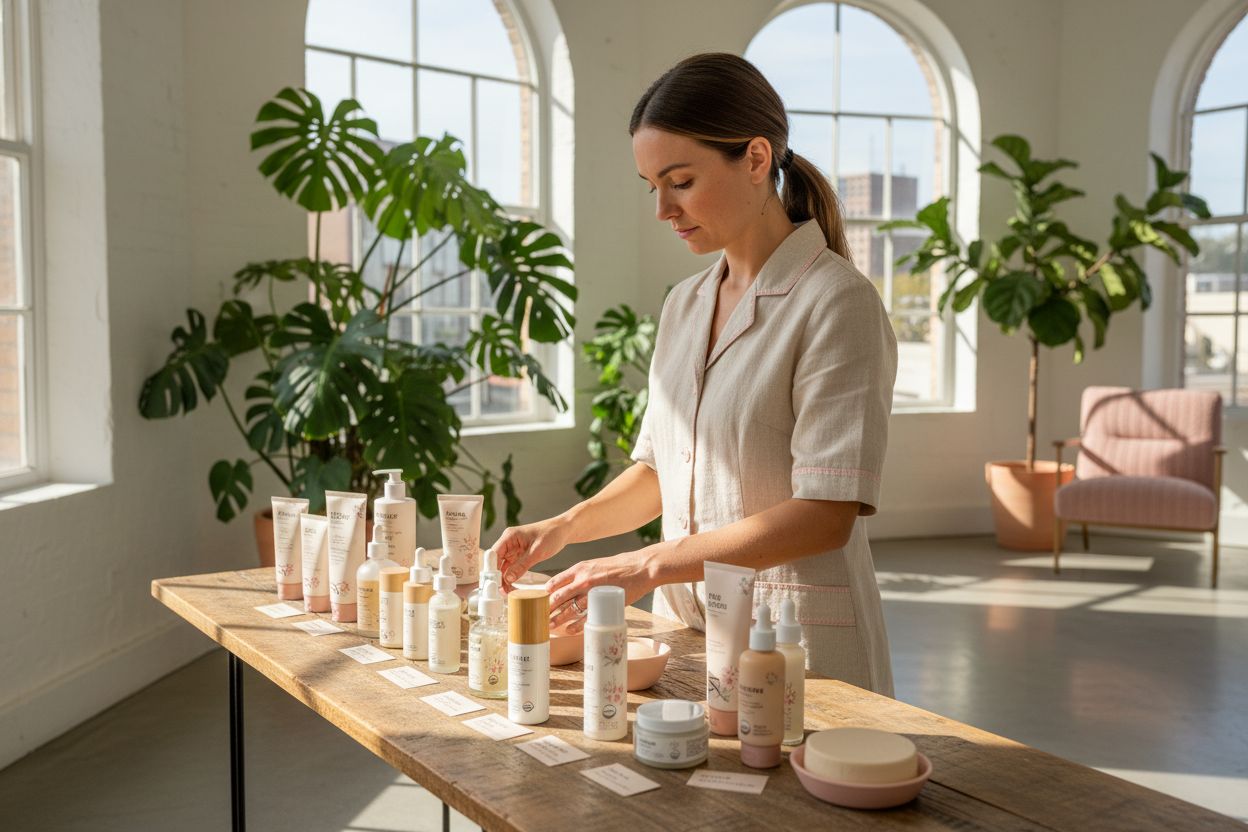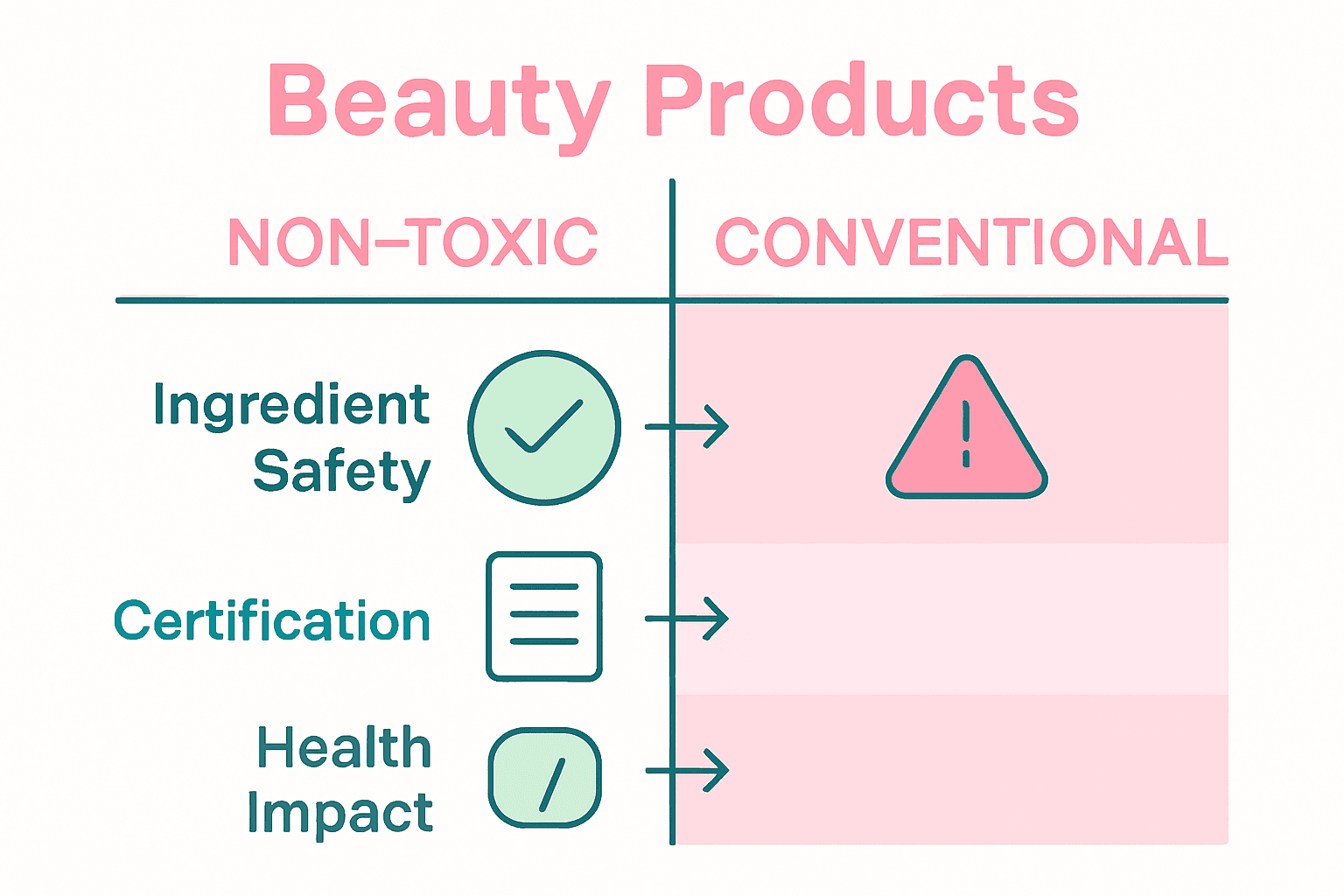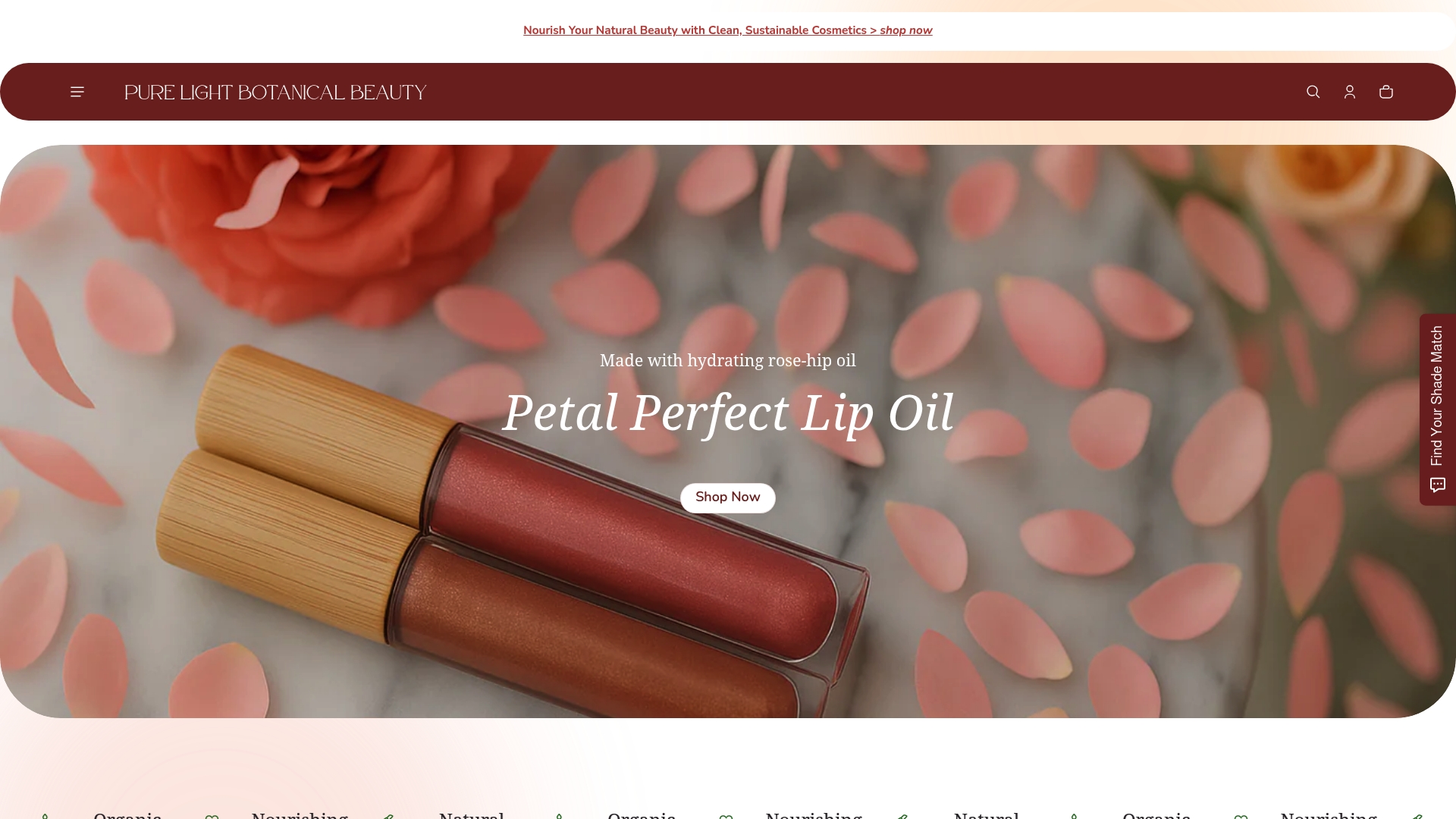Did you know the average person applies up to 168 different chemicals to their body each day through personal care products? This surprising number highlights why non-toxic beauty choices matter for anyone concerned about their health. Misinformation and clever marketing make it difficult to separate fact from fiction in beauty routines, but understanding the difference between safe and risky ingredients empowers you to make choices that protect both your skin and your long-term well-being.
Key Takeaways
| Point | Details |
|---|---|
| Understanding Non-Toxic Beauty | Non-toxic beauty focuses on avoiding harmful chemicals rather than just using natural ingredients, emphasizing product safety and long-term health. |
| Identifying Safe Products | Use reliable resources and apps to scrutinize ingredient safety and make informed beauty choices. |
| Holistic Approach | Non-toxic beauty rituals promote self-care and emotional well-being, encouraging gradual changes towards healthier options. |
| Awareness of Greenwashing | Be vigilant about marketing claims, as the industry often uses deceptive terms like “natural” to hide harmful ingredients. |
Table of Contents
- Defining Non-Toxic Beauty And Common Myths
- Understanding Toxic Ingredients In Cosmetics
- How To Identify Safe Beauty Products
- Holistic Benefits Of Non-Toxic Beauty Rituals
- Risks, Greenwashing, And What To Avoid
- Comparing Non-Toxic And Conventional Beauty
Defining Non-Toxic Beauty and Common Myths
In the evolving world of beauty, non-toxic beauty represents more than just a trend—it’s a commitment to understanding what truly nourishes and protects your skin. Unlike conventional marketing claims, non-toxic beauty isn’t simply about using “natural” ingredients, but about carefully selecting products free from potentially harmful chemicals that could compromise your long-term health. Our journey into non-toxic beauty starts with understanding that safety isn’t guaranteed just because something is labeled “natural.”
The landscape of non-toxic beauty is complex. Many consumers mistakenly believe that natural automatically means safe, but this couldn’t be further from the truth. Clean beauty terminology can be overwhelming, which is why understanding key distinctions matters. For instance, ingredients like lead and arsenic are technically natural but certainly not safe for skin application. Conversely, some synthetic ingredients can be completely harmless and even beneficial.
To navigate this nuanced terrain, experts recommend focusing on specific chemical avoidance and leveraging trusted verification tools. Key ingredients to watch out for include:
- Parabens
- Phthalates
- Synthetic fragrances
- Formaldehyde-releasing preservatives
- Petroleum-based substances
Practical strategies for identifying truly non-toxic beauty products include consulting certification resources like EWG Verified, Clean at Sephora, and utilizing apps such as Clearya and ThinkDirty. These platforms provide transparency, helping conscious consumers make informed choices that prioritize both beauty and well-being. Remember: non-toxic beauty isn’t about perfection, but about making progressively healthier choices for your skin and overall health.
Understanding Toxic Ingredients in Cosmetics
The world of cosmetic ingredients is far more complex and potentially dangerous than most consumers realize. Toxic chemicals lurk in everyday beauty products, posing significant health risks that extend far beyond surface-level concerns. Understanding nourishing makeup ingredients becomes crucial when we consider the staggering data revealing the hidden dangers in our daily beauty routines.
A groundbreaking 2024 analysis by ChemForward revealed alarming gaps in ingredient safety knowledge. Of approximately 318,000 beauty and personal care ingredients examined, one-third lack comprehensive toxicological data. Even more concerning, around 45 commonly used chemicals are classified as “high hazard,” with documented links to serious health issues including:
- Hormone disruption
- Cancer risks
- Lung irritation
- Cardiovascular complications
Recent research from NYU Langone Health provides a stark illustration of these risks. Phthalates—ubiquitous in cosmetic formulations—were linked to over 356,000 global deaths from cardiovascular disease in 2018 alone. This isn’t just about skin deep beauty; it’s about systemic health impacts that can have long-term, life-altering consequences. By understanding these toxic ingredients and making informed choices, you can protect yourself and prioritize truly safe, nourishing beauty products that support your overall well-being.
How to Identify Safe Beauty Products
Navigating the complex world of beauty product safety requires more than just good intentions—it demands strategic detective work and reliable resources. Product safety assessment has evolved beyond simple ingredient scanning, with innovative tools now empowering consumers to make informed choices. How to choose clean beauty for sensitive skin relief becomes crucial when understanding the nuanced landscape of cosmetic safety.
Technology offers powerful allies in this quest. The Environmental Working Group’s Skin Deep database stands out as a comprehensive resource, providing safety ratings for over 135,000 products. Multiple ingredient-checking apps have emerged to support consumers, including:
- INCI Decoder
- Think Dirty
- OnSkin
- Yuka
- SkinSAFE
These digital tools help users decode complex beauty packaging, assess potential risks like allergenic responses, carcinogenicity, and endocrine disruption. However, experts caution against total reliance on apps without professional guidance. The most effective approach combines technological resources with personal research, careful label reading, and an understanding of your unique skin sensitivities. By developing a critical eye and leveraging these innovative tools, you can transform your beauty routine into a safer, more mindful experience that prioritizes your long-term health and well-being.

Holistic Benefits of Non-Toxic Beauty Rituals
Non-toxic beauty transcends mere product selection—it’s a transformative journey of mindful self-care that nurtures both body and spirit. Understanding natural beauty rituals for sensitive skin reveals how our beauty routines can become powerful acts of personal wellness and intentional living.
Wellness experts emphasize that transitioning to non-toxic beauty isn’t about perfection, but about creating sustainable, meaningful change. The Safe Cosmetics Campaign recommends a personalized approach to product swapping that reduces overwhelm and supports long-term health. This might look like:
- Gradually replacing one product category at a time
- Researching ingredients mindfully
- Listening to your body’s unique responses
- Celebrating small, intentional choices
Beyond physical health, non-toxic beauty rituals offer profound emotional and psychological benefits. They transform daily routines into moments of self-reflection, connecting you more deeply with your body and personal well-being. By choosing products that align with your values, you’re not just protecting your skin—you’re cultivating a more conscious, compassionate relationship with yourself and the world around you. This holistic approach turns beauty from a superficial practice into a meaningful act of self-love and environmental stewardship.
Risks, Greenwashing, and What to Avoid
The beauty industry is rife with misleading marketing tactics that can easily confuse even the most conscientious consumer. Understanding clean beauty terminology becomes crucial in navigating the complex landscape of product claims and hidden risks.
Greenwashing remains a significant challenge, with marketing terms like “natural” and “organic” often masking potentially harmful ingredients. The Safe Cosmetics Campaign highlights particularly deceptive practices, especially around ingredient transparency. Consumers should be wary of:
- Vague “fragrance” labels that can conceal dozens of undisclosed chemicals
- Misleading “natural” or “organic” marketing claims
- Opaque ingredient disclosures
- Unsubstantiated health benefit statements
Moreover, regulatory inconsistencies pose serious health risks. A 2025 report revealed six chemicals—formaldehyde, triclosan, phthalates, Lilial, zinc pyrithione, and selenium sulfide—that remain legally used in U.S. cosmetics despite being banned in the EU, UK, and Australia due to toxicity and carcinogenic concerns. This stark reality underscores the importance of personal vigilance. By educating yourself, reading labels carefully, and prioritizing transparency, you can protect yourself from potentially harmful ingredients and make informed choices that truly support your health and well-being.
Comparing Non-Toxic and Conventional Beauty
The difference between non-toxic and conventional beauty products runs far deeper than marketing claims—it’s a fundamental approach to personal health and environmental responsibility. Ingredient safety represents the core distinction, with non-toxic formulations prioritizing transparency and holistic well-being. What is clean beauty? Fundamentally, it’s about making conscious choices that protect both your body and the broader ecosystem.
Regulatory standards reveal stark contrasts between these two beauty paradigms. Washington State’s Toxic-Free Cosmetics Act, effective January 2025, highlights these differences by banning nine toxic substances commonly found in conventional products, including:
- Formaldehyde
- Lead
- Mercury
- Ortho-phthalates
- Triclosan
- PFAS chemicals
Moreover, certification programs like the EPA’s Safer Choice label provide a rigorous framework for evaluating product safety. While conventional beauty often relies on cheaper, potentially harmful ingredients, non-toxic beauty embraces a holistic approach that considers long-term health impacts, environmental sustainability, and ingredient transparency.
 This isn’t just about avoiding toxins—it’s about choosing products that actively support your body’s natural balance, respect ecological systems, and reflect a deeper commitment to personal and planetary wellness.
This isn’t just about avoiding toxins—it’s about choosing products that actively support your body’s natural balance, respect ecological systems, and reflect a deeper commitment to personal and planetary wellness.
Here’s how non-toxic and conventional beauty products compare on key factors:
| Feature | Non-Toxic Beauty | Conventional Beauty |
|---|---|---|
| Ingredient Selection | Carefully screened | Often less regulated |
| Common Toxins Avoided | Parabens Phthalates Formaldehyde |
May include banned or restricted ingredients |
| Transparency | Emphasized | Often lacking |
| Certification Programs | EWG Verified EPA Safer Choice Clean at Sephora |
Rare or absent |
| Health Risks | Minimizes exposure | Potential hormone disruptors Carcinogens |
| Environmental Focus | Sustainability prioritized | Less emphasis on impact |
| Regulatory Bans | Adheres to stricter standards | Varies by region, often less stringent |
Experience Non-Toxic Beauty That Truly Heals
If you have ever felt overwhelmed by confusing ingredient lists or worried about the hidden toxins in your everyday beauty routine, you are not alone. This guide revealed how even well-intentioned choices can be clouded by greenwashing, vague ‘natural’ claims, and common myths about non-toxic beauty. Many conventional products expose your skin and body to harsh chemicals, leaving you searching for a skincare solution that brings real peace of mind. What if you could find makeup that supports your skin’s healing and empowers you to feel beautiful—without compromise? Discover the difference of beauty rituals designed for well-being instead of just appearance.

Let Pure Light Botanical Beauty show you what non-toxic makeup can really do. Our collection brings together safe, science-backed botanicals and nourishing self-care in every product. Each formula is carefully crafted to gently support sensitivities and celebrate your natural radiance. If you are ready to transform your routine with beauty essentials proven to respect your health, now is the perfect time to explore our holistic, clean cosmetic line. Start your journey toward safe, mindful beauty by visiting Pure Light Botanical Beauty today. Your healthiest, most luminous skin is waiting for you.
Frequently Asked Questions
What are non-toxic beauty products?
Non-toxic beauty products are formulations that avoid harmful chemicals and prioritize the use of safe, beneficial ingredients. They focus on transparency and environmental sustainability, ensuring that the ingredients used are not only safe for your skin but also for the planet.
How can I identify whether a beauty product is truly non-toxic?
To identify non-toxic beauty products, look for certifications such as EWG Verified or Clean at Sephora. Additionally, utilize ingredient-checking apps like Think Dirty or Clearya, and always read labels carefully to avoid known harmful chemicals.
What are some common toxic ingredients to avoid in cosmetics?
Common toxic ingredients to avoid include parabens, phthalates, synthetic fragrances, formaldehyde-releasing preservatives, and petroleum-based substances. These ingredients can pose various health risks, including hormone disruption and cancer.
What are the benefits of using non-toxic beauty products?
The benefits of using non-toxic beauty products include reduced exposure to harmful chemicals, support for overall health and well-being, and a more sustainable approach to beauty. These products promote a mindful self-care routine that connects you with your body and enhances your personal wellness.
Recommended
- What is Clean Beauty? Understanding Its Importance and Benefits – Pure Light Botanical Beauty
- 7 Essential Steps for a Clean Beauty Checklist Routine – Pure Light Botanical Beauty
- Clean Beauty Terminology Explained: A Deep Dive – Pure Light Botanical Beauty
- Understanding Best Practices for Natural Beauty Care – Pure Light Botanical Beauty
